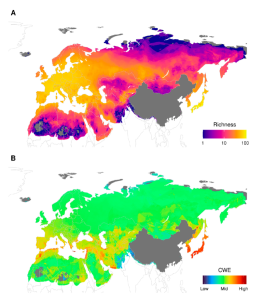
More than 1.2 million distribution records were used to create species distribution models for 402 Palaearctic species of dragonflies and damselflies. On the basis of these diversity maps of total, lentic and lotic diversity for the whole of the Palaearctic (excluding China and the Himalayan region) are presented. These maps show a clear pattern of decreasing diversity longitudinally, with species numbers dropping in the eastern half of Europe and remaining low throughout a large part of Russia, then increasing again towards Russia’s Far East and Korea. There are clear differences in diversity patterns of lentic and lotic species, with lentic species being dominant in colder and more arid areas. Areas with a high diversity of species assessed as threatened on the IUCN red list are largely restricted to the Mediterranean, Southwest Asia, and Japan, with clear hotspots found in the Levant and the southern half of Japan. The diversity at species, generic, and family level is higher in the south of Japan than in areas at a similar latitude in the western Mediterranean. This is likely to be the result of the more humid climate of Japan resulting in a higher diversity of freshwater habitats and the stronger impact of the glacial periods in the Western Palaearctic in combination with the Sahara, preventing tropical African lineages dispersing northwards.